The living room serves as the heart of your home, where family gathers and guests feel welcome. Creating the perfect atmosphere in this essential space depends largely on thoughtful lighting choices that balance function with style. Good lighting can transform a cramped room into an airy retreat or make a large space feel cozy and intimate. Whether you're reading a book, entertaining friends, or enjoying a quiet evening, the right combination of light sources sets the mood for every activity. Modern lighting design focuses on layering different types of illumination to create depth and flexibility. This approach combines ambient lighting for general brightness, task lighting for specific activities, and accent lighting to highlight your favorite features. The key lies in understanding how each element works together to brighten your space while reflecting your personal style and meeting your daily needs.
1. Layered Ambient Lighting Systems
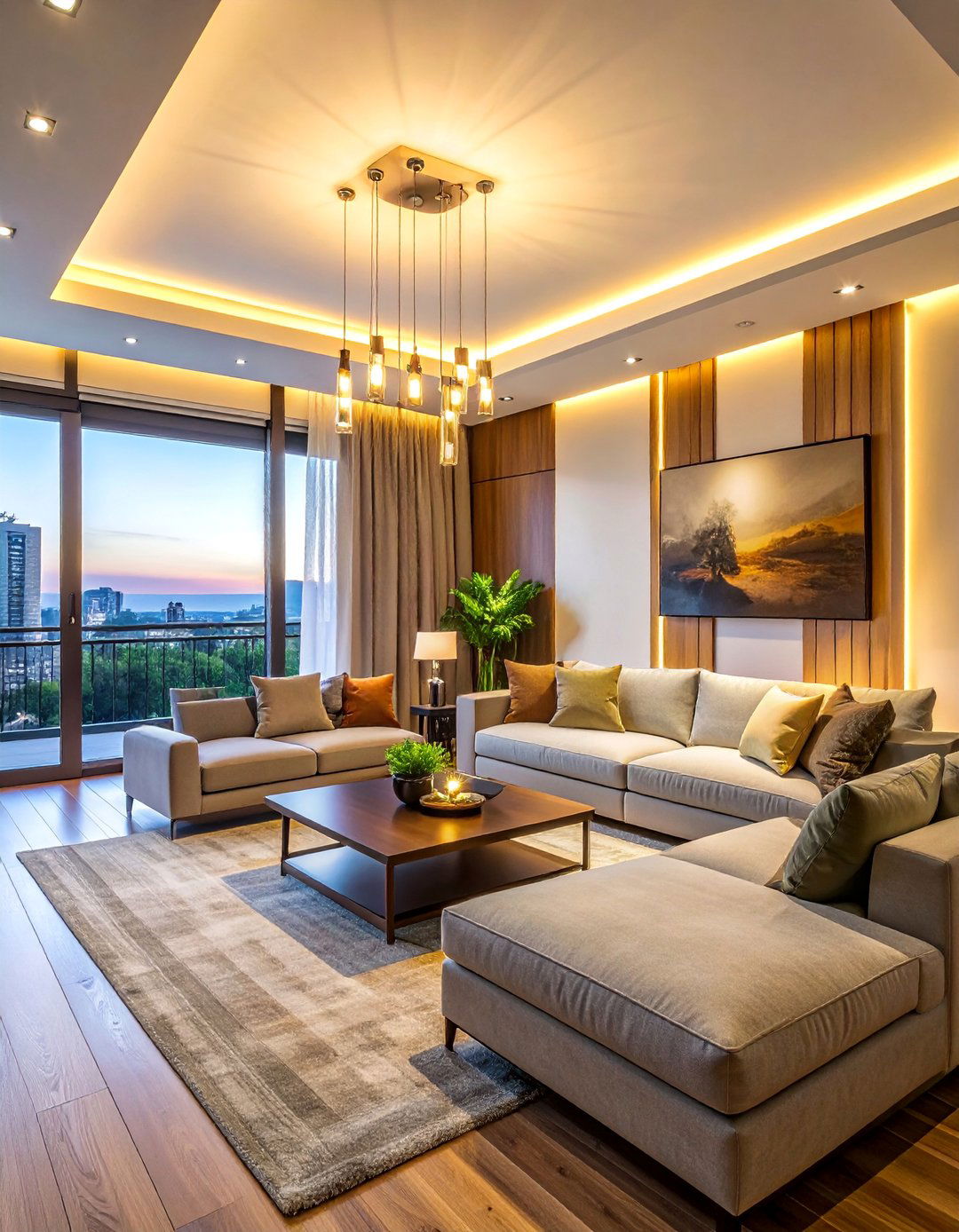
Creating a foundation of gentle, even illumination throughout your living room starts with ambient lighting that fills the space without harsh shadows. This base layer typically comes from ceiling-mounted fixtures like chandeliers, flush mounts, or recessed lighting that provides overall brightness for daily activities. The goal is establishing comfortable visibility that allows you to move safely through the room while setting a welcoming tone. Modern ambient systems often incorporate dimmer switches, letting you adjust brightness levels throughout the day. Consider installing multiple ceiling fixtures at different heights or using large pendant lights with diffused shades. Warm white bulbs around 2700K to 3000K create the most inviting atmosphere. When planning your ambient layer, think about how natural light enters your room during different times of day, then complement it with artificial sources that maintain consistent comfort levels as daylight fades.
2. Statement Chandelier Centerpieces
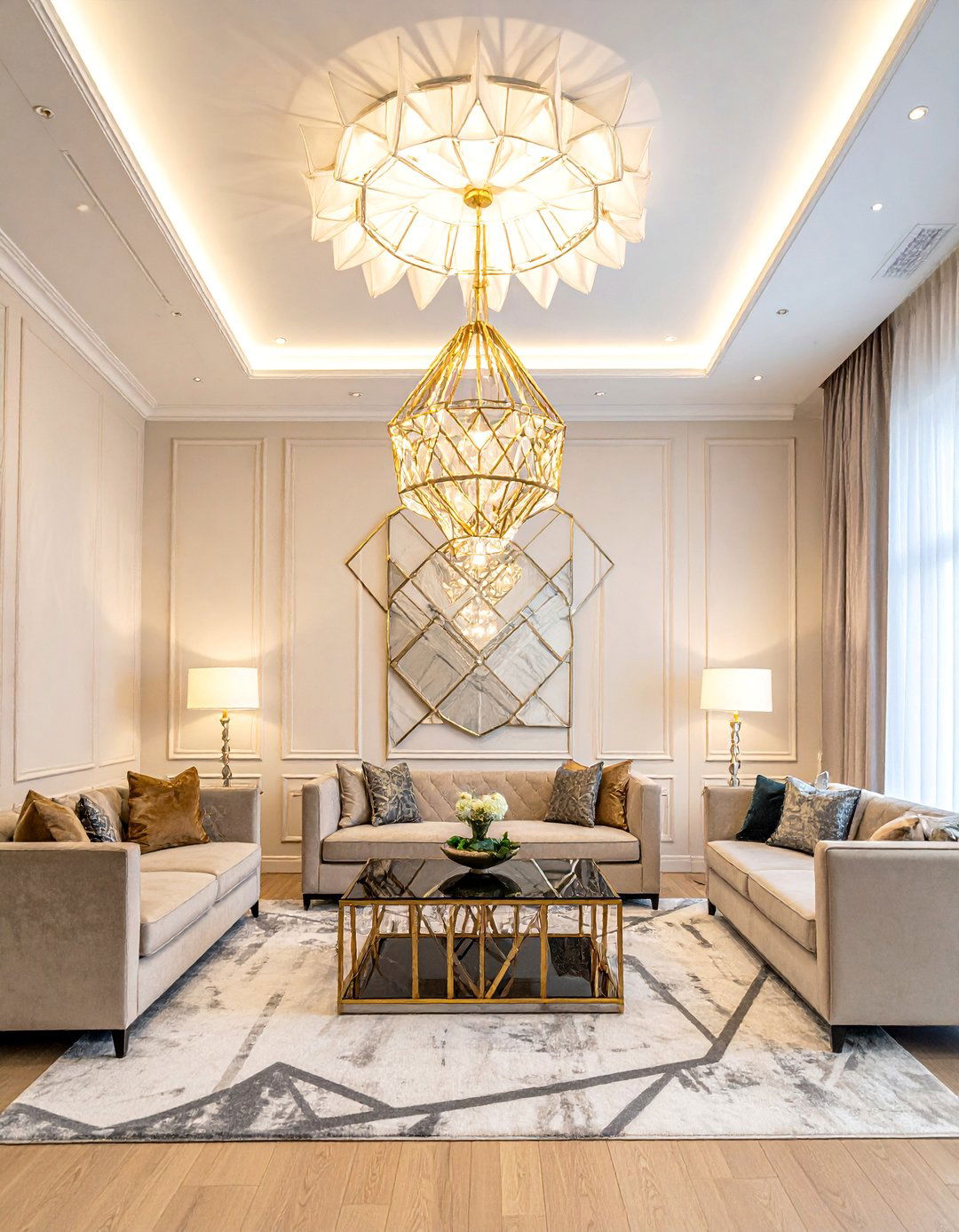
Does your living room lack a stunning focal point that draws the eye upward? A statement chandelier can transform your space into an elegant showcase while providing essential ambient lighting. Modern chandeliers range from sleek geometric designs to flowing organic shapes that complement contemporary interiors. Traditional crystal options still work beautifully in classic settings, while industrial metal fixtures suit urban aesthetics. The key is selecting a size that balances your room proportions without overwhelming the space. Generally, add your room's length and width in feet, then convert to inches for the ideal chandelier diameter. Hang your fixture about 30 to 36 inches above coffee tables or 7 feet from the floor in open areas. Consider fixtures with adjustable brightness or multiple bulb configurations that let you customize the lighting intensity for different occasions and moods.
3. Strategic Floor Lamp Placement

Floor lamps offer versatility and style while providing targeted illumination exactly where you need it most. These portable fixtures excel at filling dark corners, creating reading nooks, or adding layers to your overall lighting scheme. Arc floor lamps extend light over seating areas without requiring ceiling installation, making them perfect for renters or those avoiding electrical work. Torchiere lamps bounce light off the ceiling for soft ambient illumination, while adjustable task lamps direct focused light for reading or hobbies. Group multiple floor lamps at different heights to create visual interest and ensure even light distribution. Choose lampshades that complement your decor while diffusing light appropriately. Fabric shades create warm, cozy atmospheres, while metal or glass options provide cleaner, more contemporary looks. Position lamps near seating areas, but avoid placing them where they might be knocked over or block walking paths.
4. Pendant Light Groupings
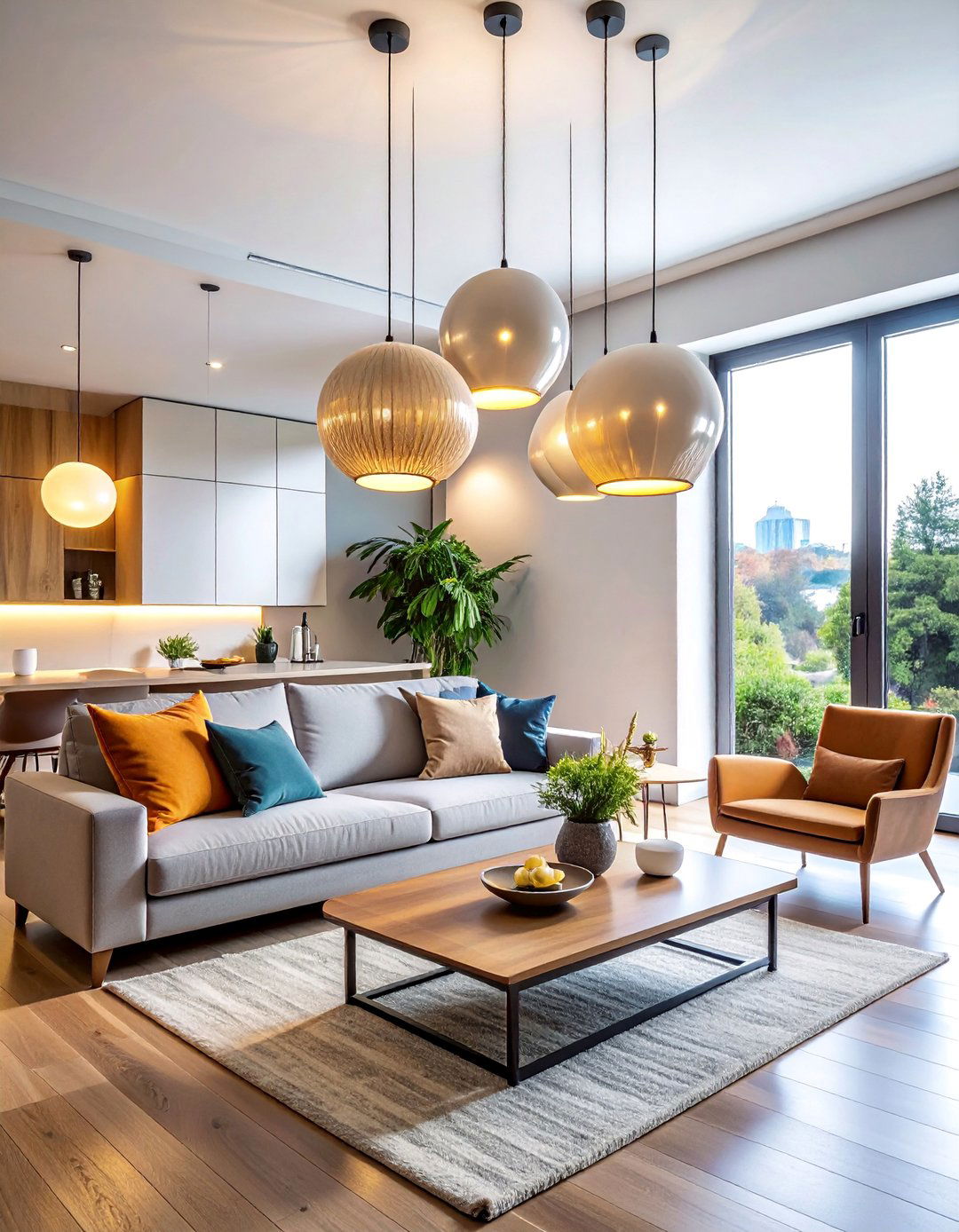
Clustering pendant lights at varying heights creates dramatic visual impact while providing excellent task and ambient lighting. This approach works especially well in open-concept living spaces where you need to define different zones without physical barriers. Hang pendants over coffee tables, side tables, or in corners to establish intimate conversation areas. Modern pendant designs range from minimalist globes to intricate woven materials that add texture and warmth. When grouping multiple pendants, use odd numbers for the most pleasing visual arrangement. Vary the heights by 6 to 12 inches to create movement and depth. Consider the scale of your furniture when selecting pendant sizes. Larger rooms can accommodate bigger fixtures, while smaller spaces benefit from delicate, streamlined designs. Install dimmer switches to adjust brightness for different activities, from bright task lighting to soft ambient glow for evening relaxation.
5. Track Lighting Flexibility
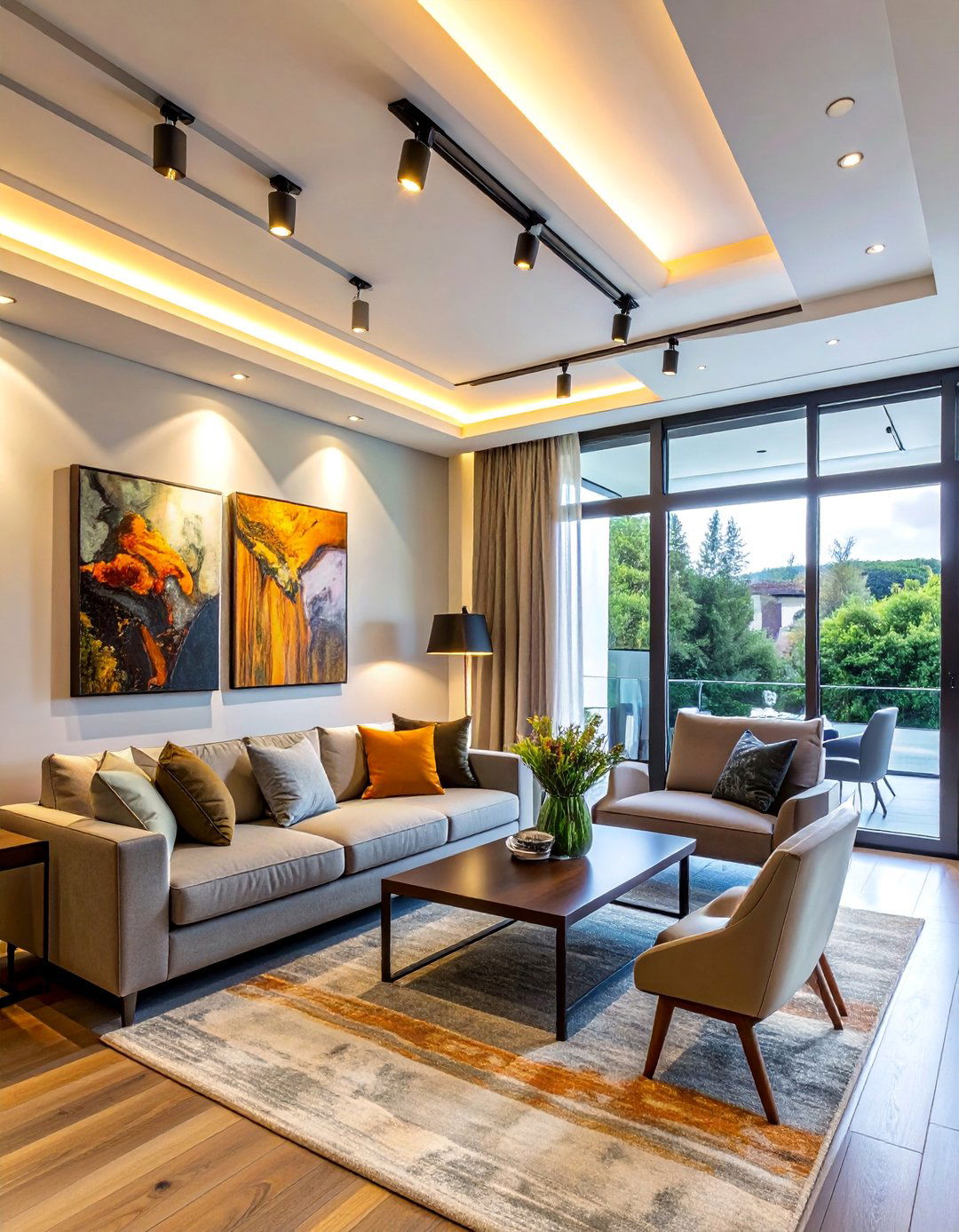
Modern track lighting systems offer unmatched flexibility for highlighting artwork, architectural features, or creating focused task lighting where you need it most. These systems allow you to position and reposition fixtures along a track, adapting your lighting as your space evolves. Contemporary track designs are sleek and minimal, blending seamlessly into modern interiors without the industrial appearance of older systems. Each fixture head can be adjusted independently, letting you direct light precisely where it's needed. This makes track lighting ideal for illuminating gallery walls, bookshelves, or accent furniture. Magnetic track systems offer the ultimate convenience, allowing you to move fixtures without tools. Consider low-profile or recessed tracks for the cleanest appearance. Mix different beam angles within the same system to create both focused spotlighting and broader wash lighting. Smart track systems even allow individual fixture control through mobile apps.
6. Table Lamp Coordination

How do you create cohesion while adding personality to your living room lighting? Coordinating table lamps across your space establishes visual rhythm while providing essential task lighting for reading, writing, or detailed work. Choose lamps with similar base materials, shade shapes, or color palettes to create unity, but avoid identical pairs that might look too formal or hotel-like. Mix heights and sizes for visual interest while maintaining a common design thread. Position table lamps on side tables, console furniture, or shelving units to create pools of warm light throughout the room. The bottom of lamp shades should be at eye level when seated to prevent glare. Consider the lamp's proportion to its surface – the lampshade should be no wider than the table it sits on. Layer table lamps with other lighting types to create depth and ensure adequate illumination for all your activities while maintaining the cozy, intimate atmosphere that makes living rooms so inviting.
7. Wall Sconce Symmetry

Wall sconces save valuable floor and table space while adding architectural interest to your living room walls. These fixtures work particularly well for flanking artwork, mirrors, or architectural features like fireplaces. Symmetrical sconce placement creates formal, balanced compositions that suit traditional and transitional interiors. Install sconces at eye level, typically 60 to 66 inches from the floor, to ensure proper light distribution without glare. Choose sconces that complement your room's style – sleek metal designs for modern spaces, ornate fixtures for traditional rooms, or natural materials for casual settings. Uplighting sconces bounce light off the ceiling for ambient illumination, while downlighting versions provide focused task lighting. Consider sconces with adjustable arms for flexibility in directing light. Install dimmer switches to control brightness levels for different occasions. Remember that sconces should enhance your existing lighting scheme rather than serve as the primary light source in most living room applications.
8. Recessed Lighting Grids
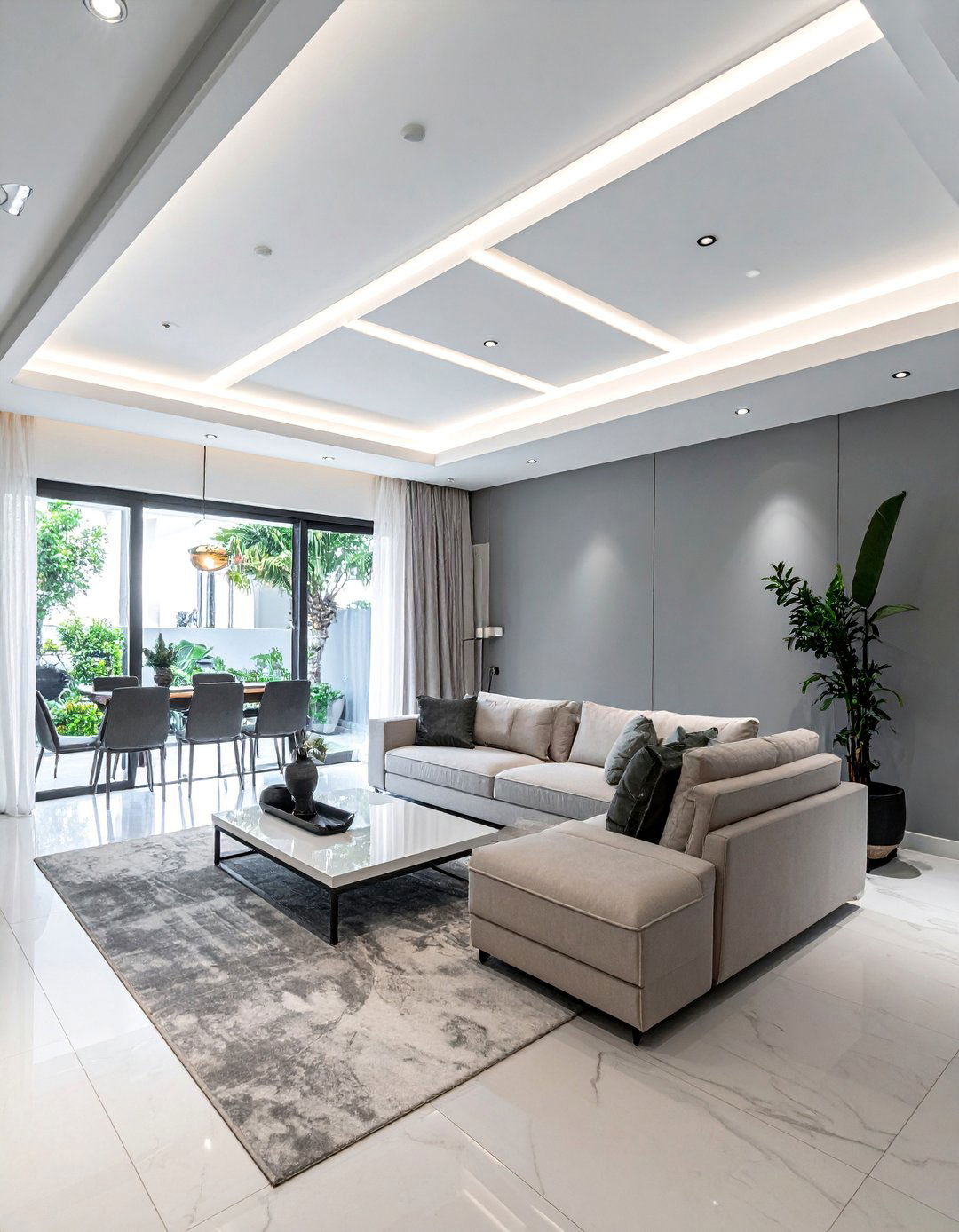
Recessed lighting provides clean, unobtrusive illumination that works beautifully in contemporary living rooms where minimalist aesthetics are important. These fixtures disappear into the ceiling, creating ambient light without visual clutter. Plan your recessed light layout carefully – fixtures should be spaced evenly and positioned to avoid shadows on seating areas. A common guideline suggests spacing fixtures about 4 to 6 feet apart, depending on ceiling height and beam spread. Choose fixtures with adjustable trims to direct light where needed most. Avoid the common mistake of installing too many recessed lights, which can create an overly bright, commercial appearance. Instead, use recessed lighting as part of a layered scheme that includes other fixture types. Consider different beam angles within the same installation – narrow spots for accent lighting and wide floods for general illumination. LED recessed fixtures offer energy efficiency and long life while providing excellent color rendering for true-to-life appearance of furnishings and finishes.
9. Cove Lighting Ambiance

Cove lighting creates magical ambient illumination by hiding LED strips behind architectural elements like crown molding, floating shelves, or ceiling recesses. This indirect lighting technique washes walls with soft, even light that makes rooms appear larger and more sophisticated. The hidden light source eliminates glare while providing gentle background illumination perfect for relaxation and entertaining. Install LED strips in continuous runs for the most even light distribution. Choose warm white color temperatures around 2700K to 3000K for cozy residential atmospheres. Dimmer controls are essential for adjusting brightness throughout the day and evening. Cove lighting works particularly well for highlighting textured walls, architectural details, or creating separation between different areas in open floor plans. Consider color-changing LED strips for special occasions or mood lighting. The key to successful cove lighting lies in proper installation that completely conceals the light source while providing smooth, uninterrupted illumination that enhances your room's architectural character.
10. Picture Lighting Displays

Illuminate your artwork and collections with dedicated picture lighting that transforms your living room into a personal gallery. Picture lights mounted above artwork provide focused illumination that reveals colors, textures, and details while creating dramatic focal points. LED picture lights offer energy efficiency and minimal heat output that won't damage sensitive artwork. Choose fixtures that span about two-thirds the width of your artwork for optimal coverage. Position lights to avoid glare when viewing from common seating positions. Track lighting with narrow beam spotlights offers flexibility for changing displays. Consider wireless, battery-operated picture lights for easy installation without electrical work. Museum-quality lighting requires careful attention to UV protection and color rendering. For valuable artwork, consult with lighting professionals about proper illumination levels and conservation concerns. Picture lighting should be part of a layered scheme that includes ambient lighting to prevent harsh contrasts between illuminated artwork and surrounding areas.
11. Reading Nook Task Lighting

Creating the perfect reading corner requires thoughtful task lighting that provides sufficient illumination without eye strain or glare. Position adjustable floor lamps or table lamps to shine light over your shoulder onto the reading material, avoiding shadows on the page. The light source should be bright enough for comfortable reading but not so harsh that it creates uncomfortable contrasts with surrounding areas. Reading lights typically need about 450 to 500 lumens for optimal visibility. Choose lamps with adjustable arms or swiveling heads that let you direct light precisely where needed. Natural daylight bulbs around 4000K provide excellent visibility for detailed tasks, though many readers prefer warmer 3000K for evening comfort. Consider swing-arm wall sconces for space-saving solutions that don't require floor or table space. Layer reading task lighting with gentle ambient illumination to reduce eye strain and create a comfortable environment for extended reading sessions that transforms any corner into your personal literary retreat.
12. Fireplace Accent Lighting
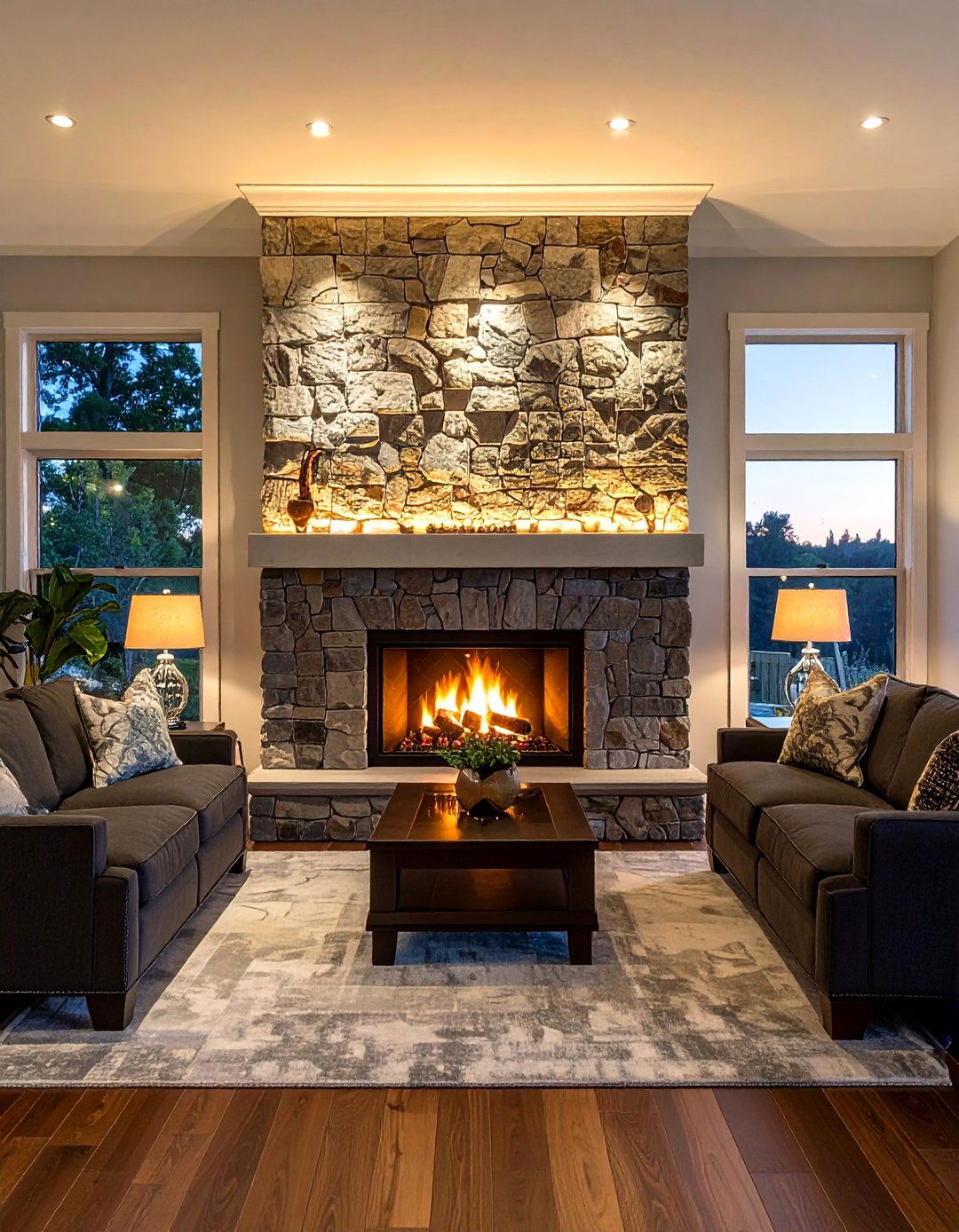
Does your fireplace command attention even when it's not in use? Strategic accent lighting can highlight this natural focal point while creating cozy ambiance throughout your living room. Install recessed lights in the mantel or surround to showcase stonework, tile, or architectural details. LED strip lights hidden behind the mantel create subtle uplighting that emphasizes the fireplace's presence. Flank the fireplace with matching table lamps or floor lamps to create symmetrical balance. Wall sconces on either side provide ambient lighting while framing the fireplace beautifully. Consider installing lights inside the firebox itself for year-round ambiance when the fireplace isn't being used for actual fires. Warm color temperatures around 2700K enhance the cozy feeling associated with fireplaces. Dimmer controls allow you to adjust lighting intensity to complement or replace the natural glow of actual flames. Coordinate fireplace lighting with the rest of your room's lighting scheme to ensure the area feels integrated rather than isolated.
13. Entertainment Center Illumination

Modern entertainment centers benefit from carefully planned lighting that reduces eye strain during screen time while highlighting media equipment and displays. Install LED strip lights behind wall-mounted televisions to create bias lighting that reduces contrast between bright screens and dark surroundings. This technique lessens eye fatigue during extended viewing sessions. Hide LED strips behind floating shelves or within entertainment cabinets to illuminate components and collectibles without creating glare on screens. Use warm white or color-changing LEDs that can be adjusted for different viewing preferences. Consider smart lighting systems that automatically adjust based on content being watched. Rope lights or LED tape hidden within media furniture create subtle accent lighting that adds sophistication to entertainment areas. Avoid placing bright lights directly beside screens where they might cause reflections or visual distractions. Coordinate entertainment lighting with your room's overall lighting scheme, ensuring smooth transitions between bright task lighting for reading and dimmer ambient lighting for movie watching.
14. Natural Light Enhancement
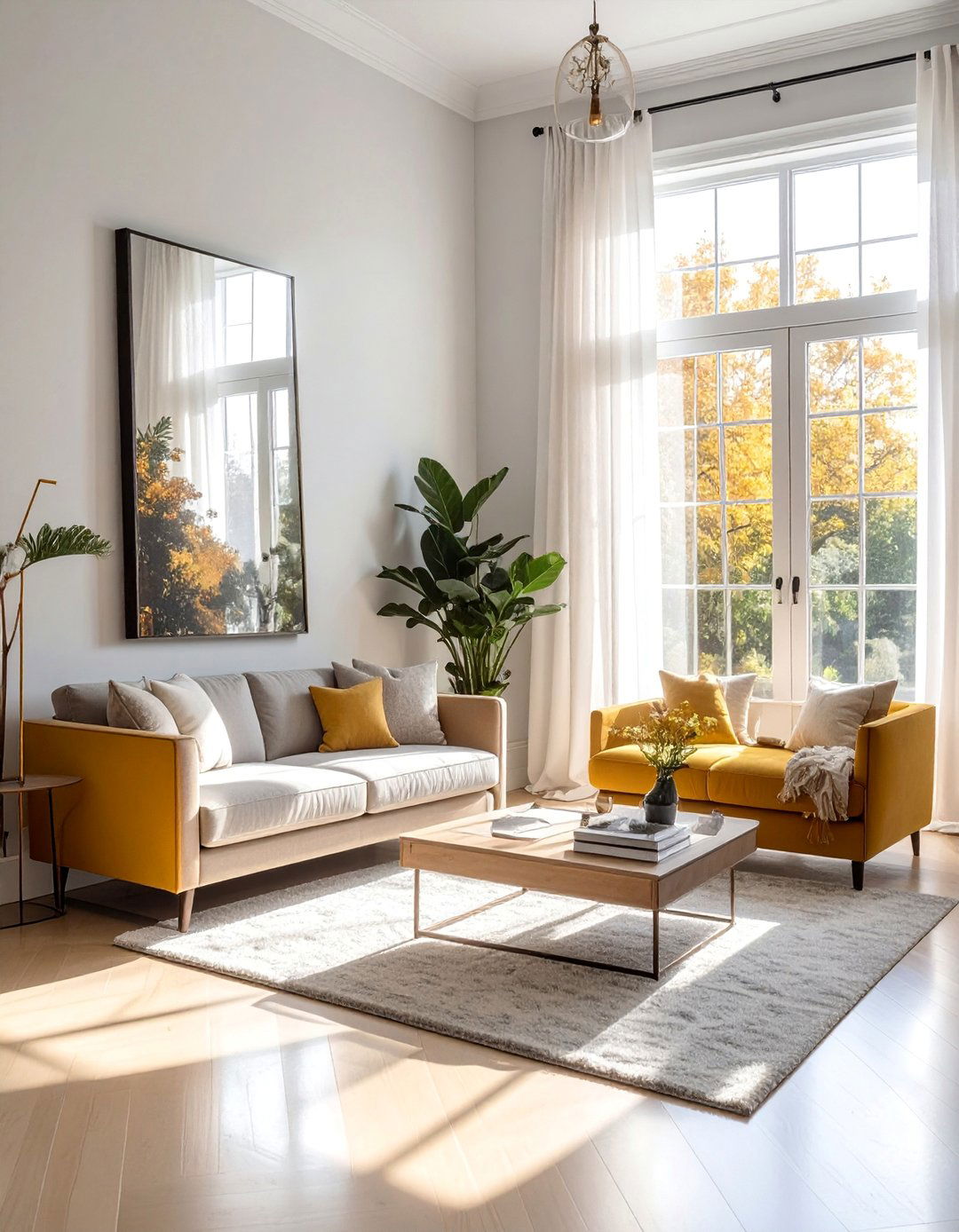
Maximizing natural light in your living room creates the foundation for all other lighting decisions while reducing daytime energy consumption. Position mirrors strategically to reflect and multiply available daylight throughout the space. Large mirrors opposite windows double the apparent light while making rooms feel more spacious. Choose window treatments that provide privacy when needed while allowing maximum light penetration during the day. Sheer curtains, light-filtering blinds, or top-down bottom-up shades offer flexible light control. Keep windows clean and unobstructed by furniture or plants that might block precious daylight. Light-colored walls and ceilings reflect more natural light throughout the room. Consider skylights or light tubes in rooms with limited window access. During evening hours, layer artificial lighting to maintain the bright, airy feeling that natural light provides. Use daylight-balanced LED bulbs in areas where you need accurate color perception for tasks like reading or crafts.
15. Smart Lighting Integration
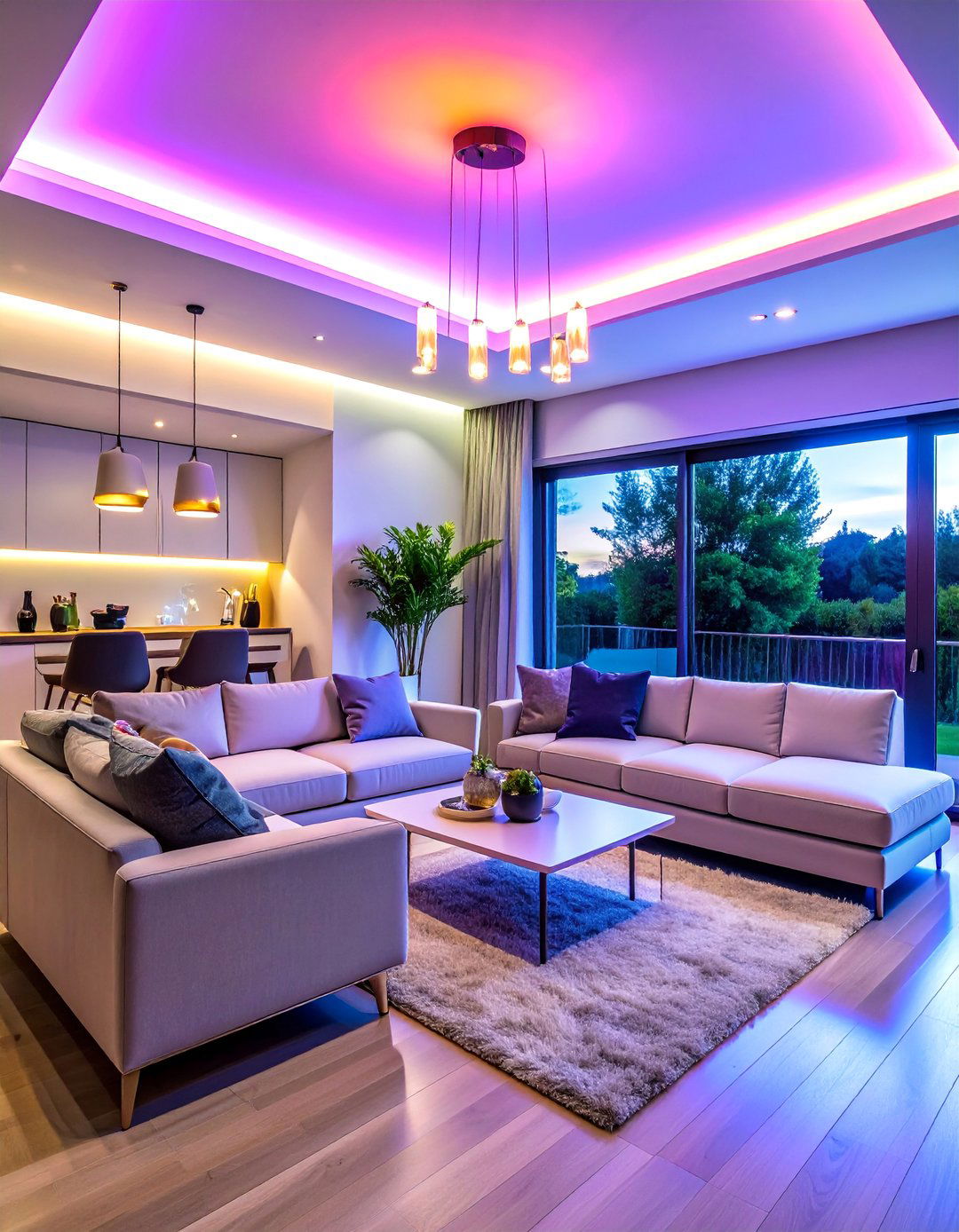
Smart lighting systems revolutionize how you control and experience living room illumination through smartphone apps, voice commands, and automated scheduling. These systems allow you to adjust brightness, color temperature, and even create custom lighting scenes for different activities or times of day. Program morning scenes with bright, energizing light that gradually transitions to warm, relaxing tones for evening. Smart dimmers work with existing fixtures to add intelligence to traditional lighting. Color-changing smart bulbs let you customize ambiance for parties, relaxation, or seasonal celebrations. Many systems integrate with home automation platforms for seamless control alongside other smart home devices. Motion sensors can automatically illuminate pathways or gradually increase lighting when someone enters the room. Schedule lights to simulate occupancy when away from home for security purposes. Some smart systems even adjust automatically based on natural light levels or time of day. Consider starting with smart switches or smart bulbs in key fixtures, then expanding the system as you discover new ways technology can enhance your lighting experience.
16. Industrial Style Track Systems

Industrial-inspired track lighting brings urban sophistication to contemporary living rooms through exposed metal fixtures and utilitarian aesthetics. Black or brushed steel tracks with adjustable spot lights create flexible illumination that can be redirected as your room layout changes. This style works particularly well in loft apartments, modern homes, or spaces with exposed ceiling elements like beams or ductwork. Industrial track systems often feature Edison-style bulbs or vintage-inspired shades that add warmth to the raw metal components. Position tracks to highlight artwork, architectural features, or create task lighting for reading areas. The adjustable nature of track lighting makes it ideal for spaces that serve multiple functions throughout the day. Choose fixtures with different beam angles to provide both accent and ambient lighting from the same system. Consider copper or brass accents to warm up industrial fixtures. Industrial lighting pairs beautifully with exposed brick, concrete floors, or reclaimed wood furniture. Modern industrial designs offer cleaner lines and more refined finishes while maintaining the style's characteristic functionality and adaptability.
17. Crystal Chandelier Elegance

Traditional crystal chandeliers bring timeless elegance and sparkling brilliance to formal living rooms where luxury and sophistication are priorities. These fixtures refract light through cut crystal or glass elements, creating beautiful patterns and rainbow effects throughout the space. Modern crystal chandeliers often combine traditional elements with contemporary silhouettes for updated elegance that suits both classic and transitional interiors. The size and style of your crystal chandelier should complement your room's scale and furnishings. Larger rooms can accommodate dramatic multi-tier chandeliers, while smaller spaces benefit from simpler designs with fewer crystal elements. Regular cleaning maintains the brilliant sparkle that makes crystal lighting so appealing. LED bulbs in crystal chandeliers provide energy efficiency while ensuring excellent light output and minimal heat that could damage delicate crystal components. Consider dimmer switches to control the intensity of crystal lighting for different occasions. Position crystal chandeliers as centerpieces that anchor formal seating arrangements while providing ambient illumination enhanced by the decorative sparkle that only crystal can provide.
18. Minimalist Flush Mount Solutions
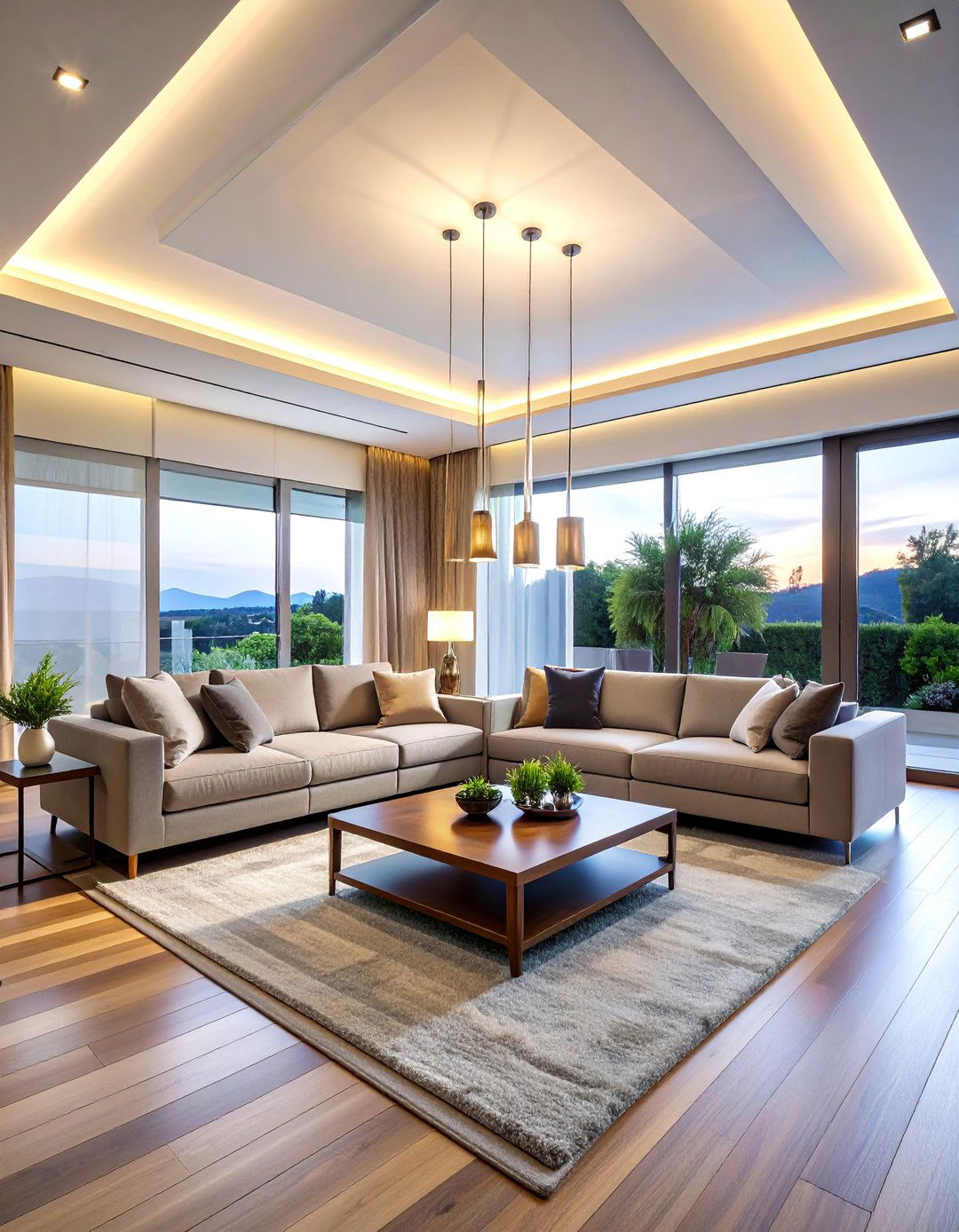
Flush mount fixtures offer clean, streamlined lighting solutions for living rooms with lower ceilings or contemporary design aesthetics that emphasize simplicity. These fixtures mount directly against the ceiling, providing ambient illumination without visual bulk or hanging elements that might overwhelm smaller spaces. Modern flush mounts feature sophisticated materials like brushed metals, natural woods, or frosted glass that complement minimalist interiors. LED flush mounts provide excellent energy efficiency and even light distribution while maintaining slim profiles. Choose fixtures with diffused covers to eliminate harsh shadows and provide comfortable ambient lighting. Multiple flush mounts can be arranged in patterns across larger ceilings for even illumination. Some designs incorporate adjustable elements or multiple light sources within single fixtures for added functionality. Consider flush mounts with integrated dimming capabilities for flexible brightness control. These fixtures work particularly well in contemporary or Scandinavian-inspired living rooms where clean lines and uncluttered appearances are essential design elements. Quality flush mounts prove that simple doesn't mean boring when thoughtfully selected and properly positioned.
19. Sculptural Floor Lamp Statements
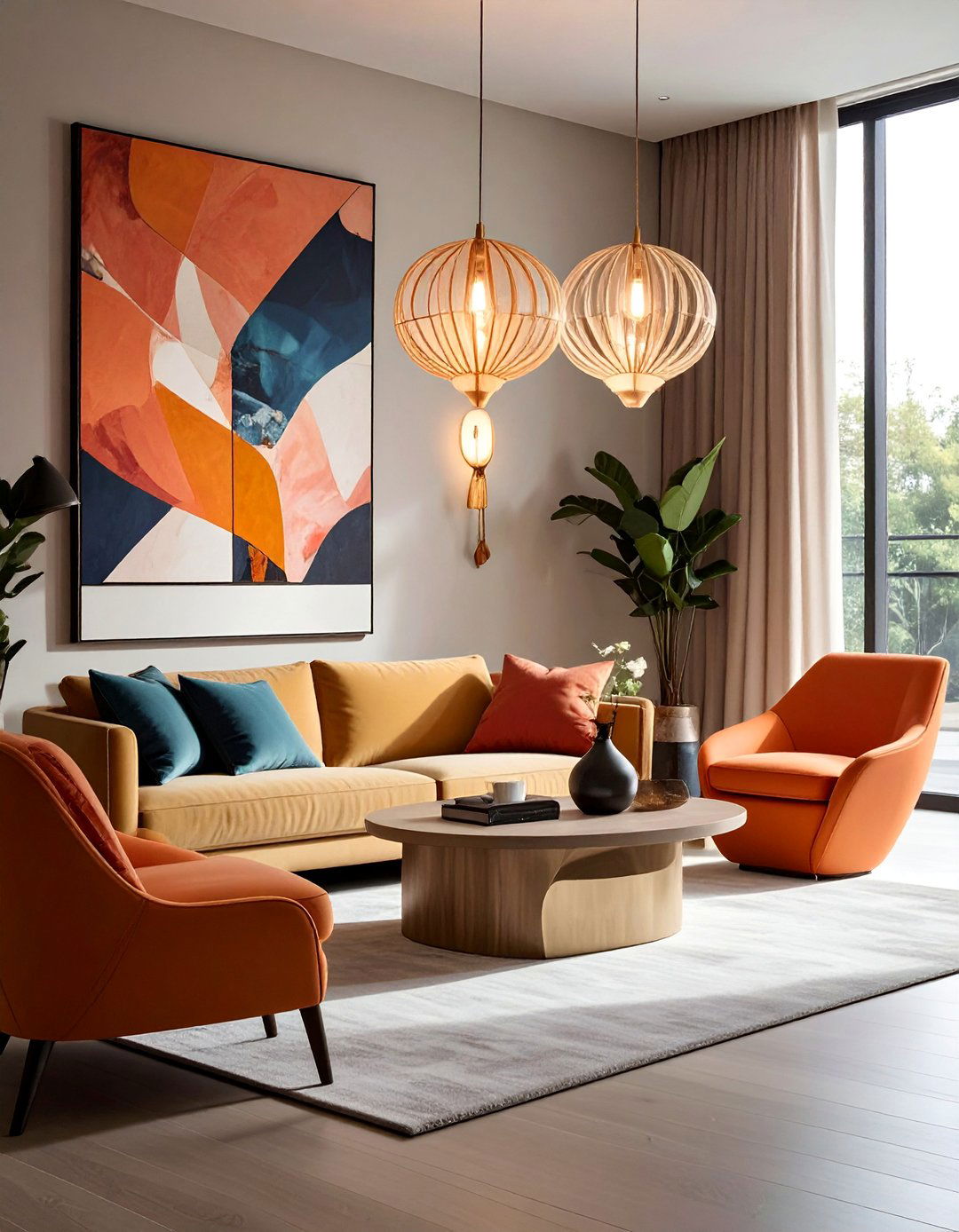
Transform your living room with sculptural floor lamps that function as both lighting and art pieces, creating dramatic focal points while providing essential illumination. These statement fixtures often feature unique materials, unusual shapes, or artistic designs that spark conversation and reflect your personal style. Arc lamps with sweeping curves reach over seating areas without requiring ceiling installation, while geometric bases add architectural interest to modern spaces. Natural materials like wood, stone, or woven fibers bring organic warmth to contemporary interiors. Oversized drum shades or multiple arm configurations create impressive visual presence while distributing light effectively throughout the room. Consider how sculptural lamps interact with your existing furniture and decor. Some designs work best as standalone features, while others complement grouped arrangements. LED bulbs in sculptural fixtures provide longevity and energy efficiency while reducing heat output that might affect delicate materials. Position statement floor lamps where they won't be bumped or knocked over, typically in corners or beside substantial furniture pieces. Quality sculptural lighting investments become treasured design elements that elevate your living room's aesthetic sophistication.
20. Vintage Edison Bulb Warmth
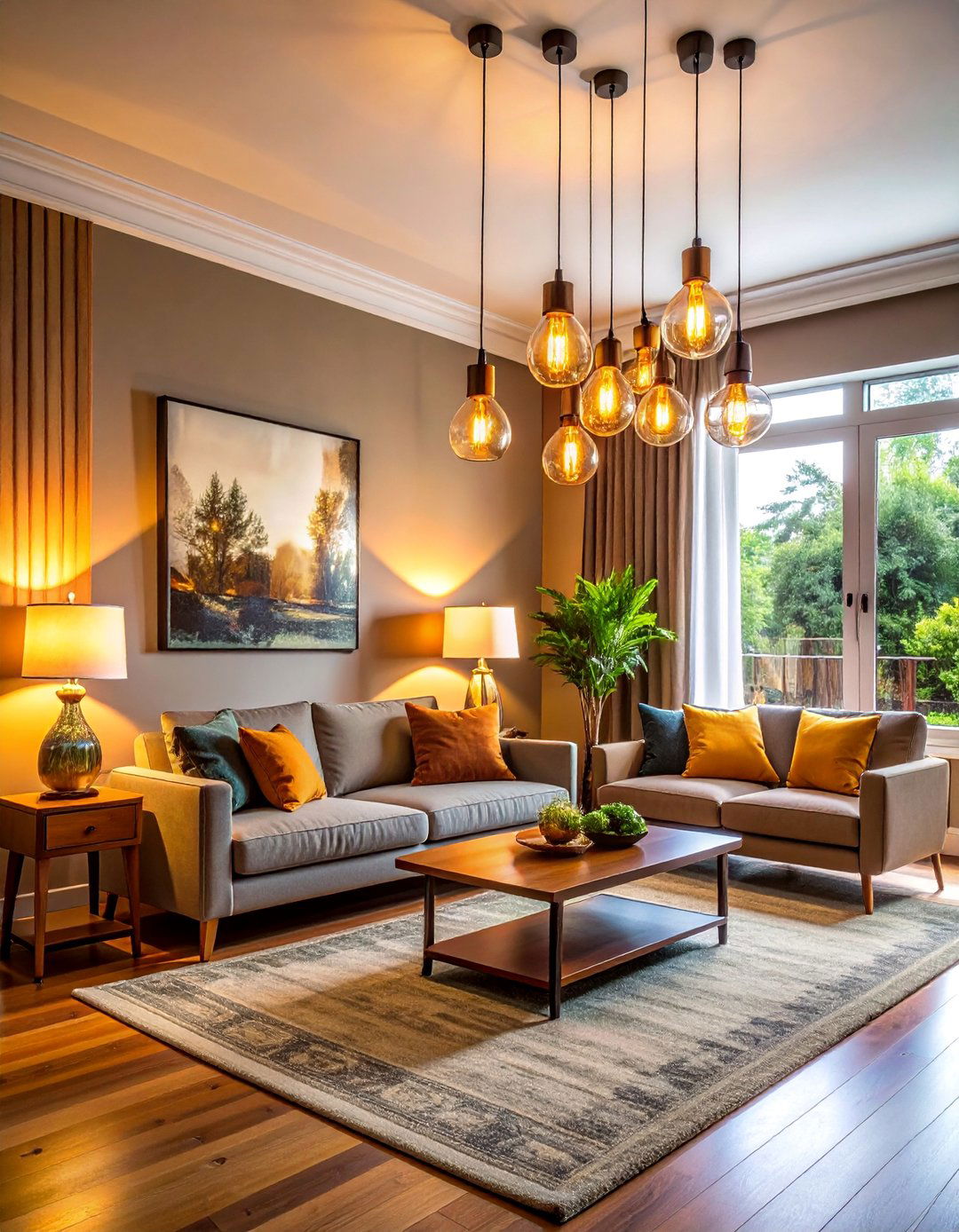
Edison-style bulbs bring nostalgic warmth and character to living room fixtures while providing the perfect amber glow for cozy evenings and intimate gatherings. These bulbs feature visible filaments that create beautiful patterns of light while evoking early electric lighting's romantic appeal. Modern LED Edison bulbs offer the same aesthetic with improved energy efficiency and longer lifespans than traditional incandescent versions. Use Edison bulbs in pendant lights, chandeliers, or table lamps where the decorative filament patterns can be appreciated. The warm color temperature, typically around 2200K to 2700K, creates relaxing atmospheres perfect for unwinding after busy days. Dimmer switches enhance the vintage bulb experience by allowing you to adjust brightness while maintaining the characteristic warm glow. Edison bulbs work particularly well in industrial, farmhouse, or eclectic interiors where character and personality are valued over stark modern efficiency. Consider mixing different Edison bulb shapes and sizes within the same fixture for added visual interest. These bulbs pair beautifully with exposed fixtures, wire cages, or vintage-inspired hardware that celebrates the early days of electric lighting.
Conclusion:
Creating perfect living room lighting involves thoughtful planning that balances function, style, and personal preferences while enhancing your space's natural character. The most successful lighting schemes layer multiple sources at different heights and intensities, providing flexibility for various activities throughout the day. Whether you prefer dramatic chandeliers, minimalist recessed fixtures, or eclectic combinations of vintage and modern elements, the key lies in understanding how different lighting types work together. Smart technology offers new possibilities for customizing and controlling your lighting experience, while traditional approaches remain timelessly effective. Remember that lighting significantly impacts mood, functionality, and perceived room size, making it one of your most powerful design tools. Start with good ambient lighting as your foundation, then add task and accent layers that reflect your lifestyle and aesthetic preferences. With careful planning and quality fixtures, your living room lighting will create the perfect atmosphere for relaxation, entertainment, and daily activities while showcasing your unique style and enhancing your home's overall appeal.


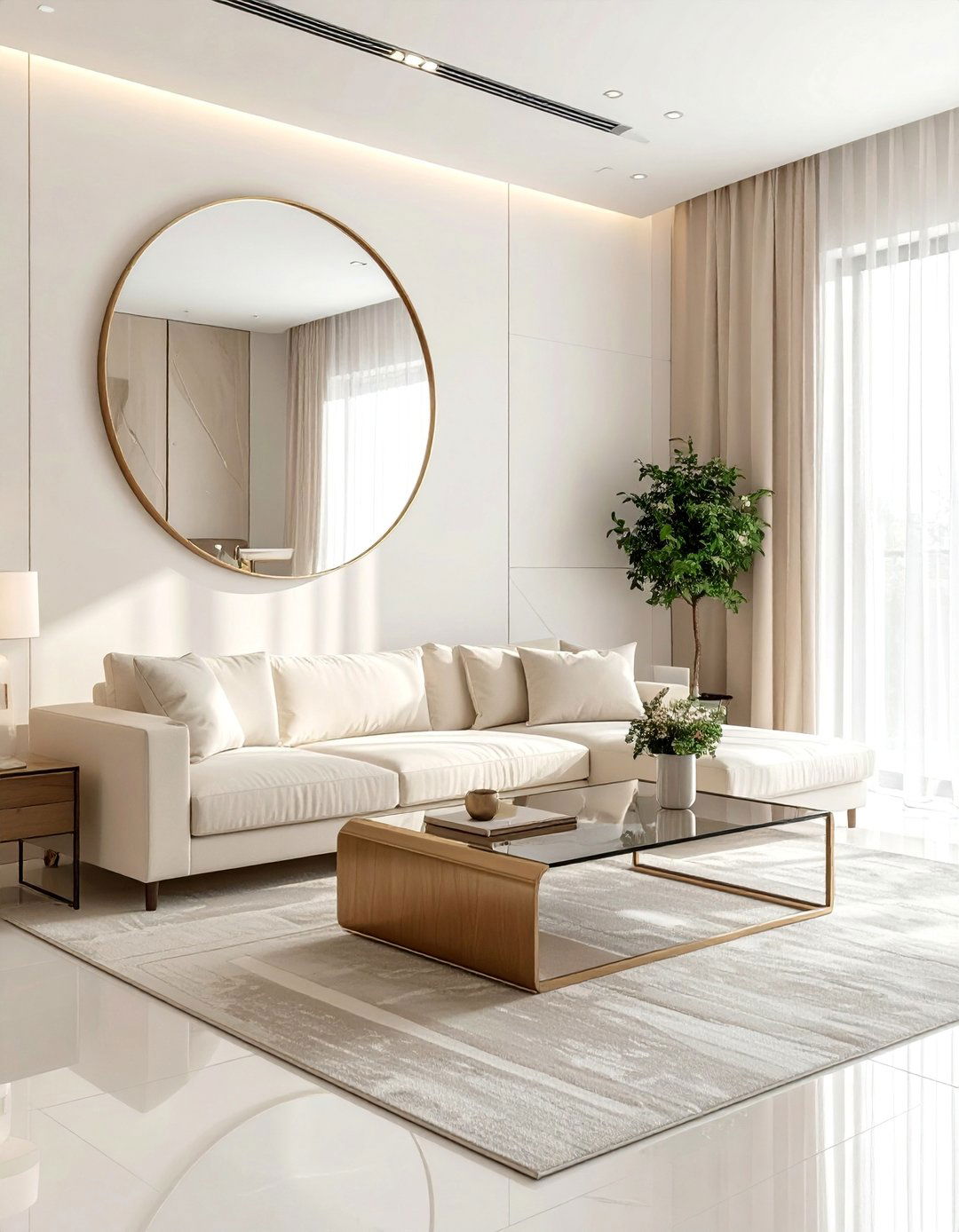
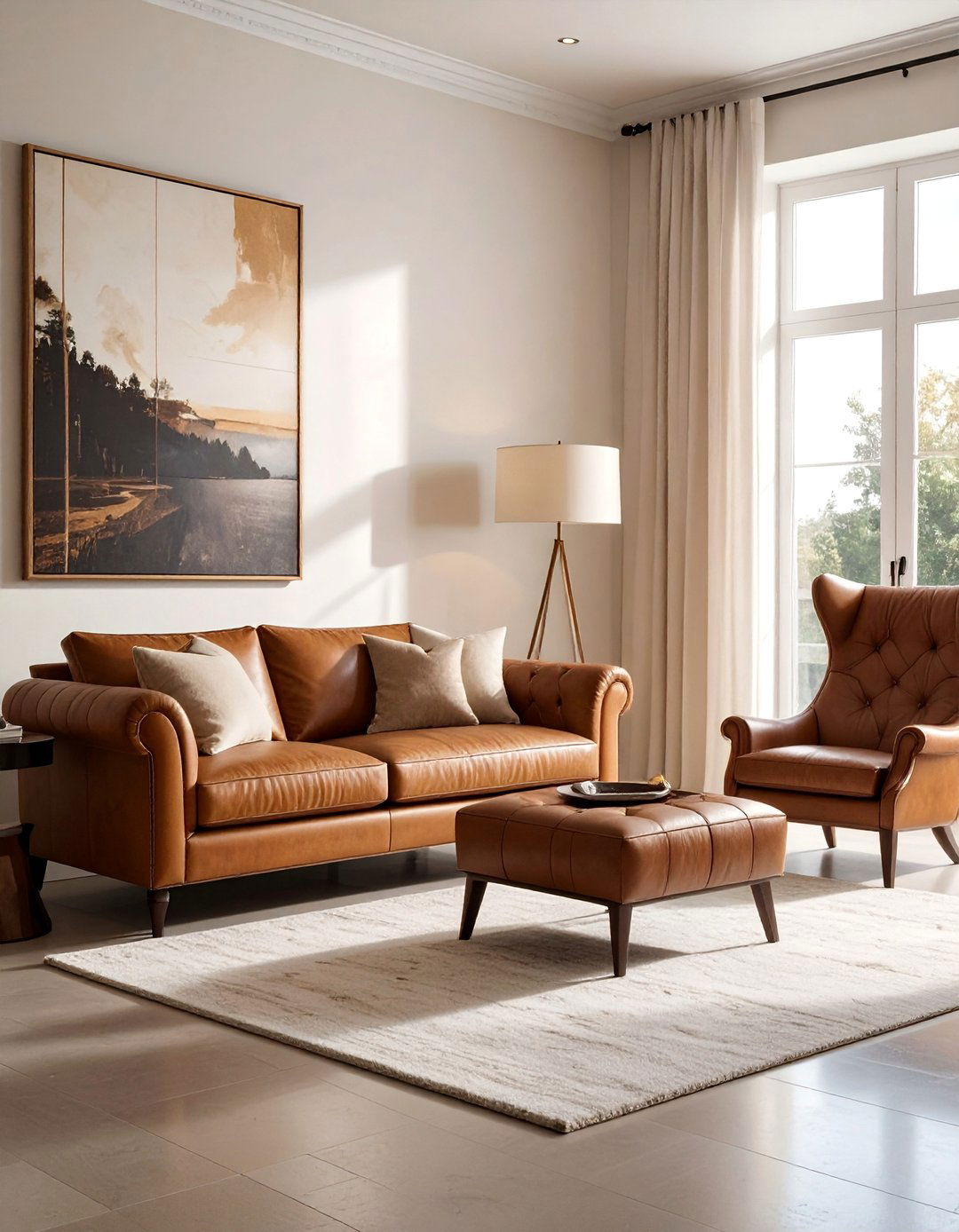
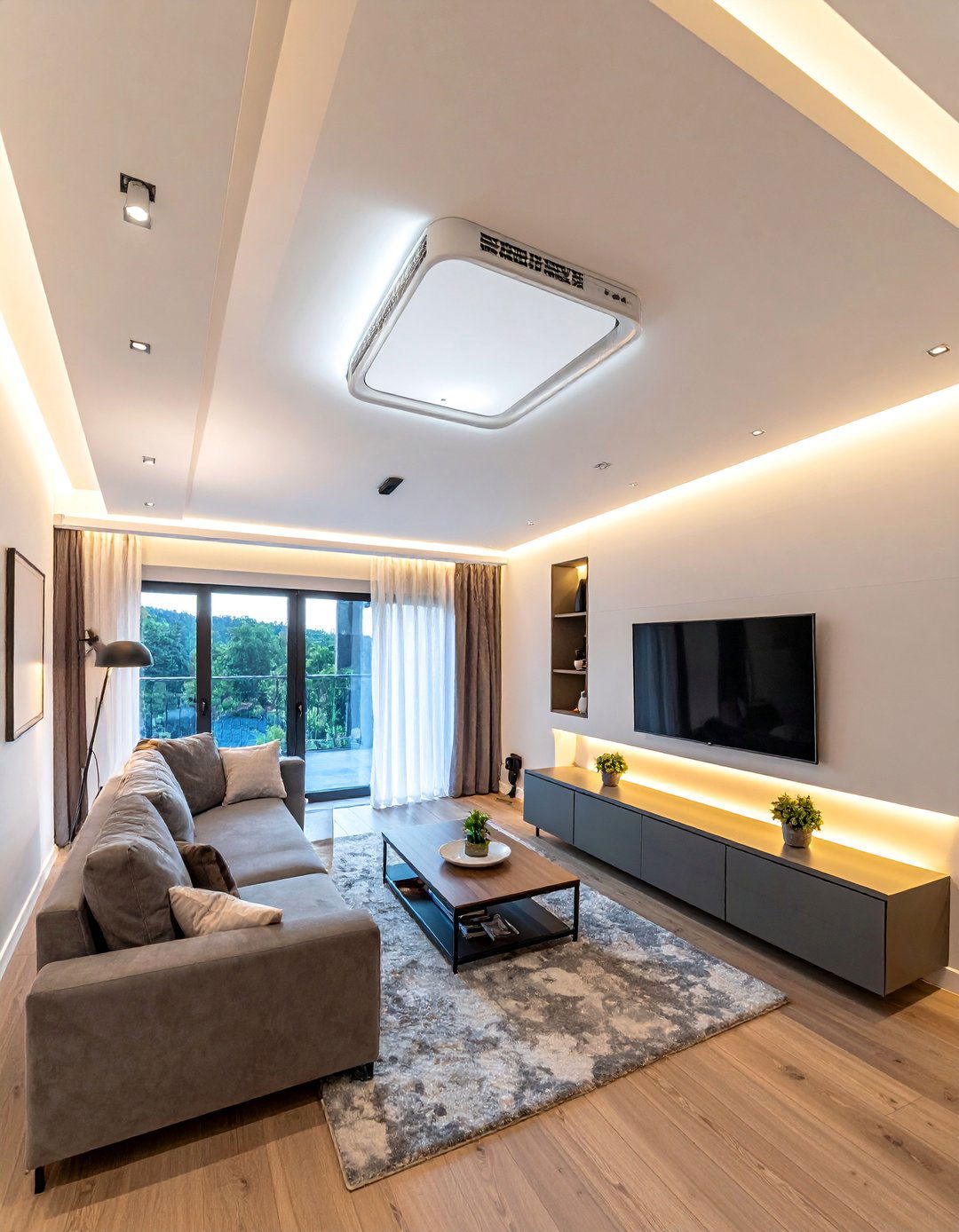


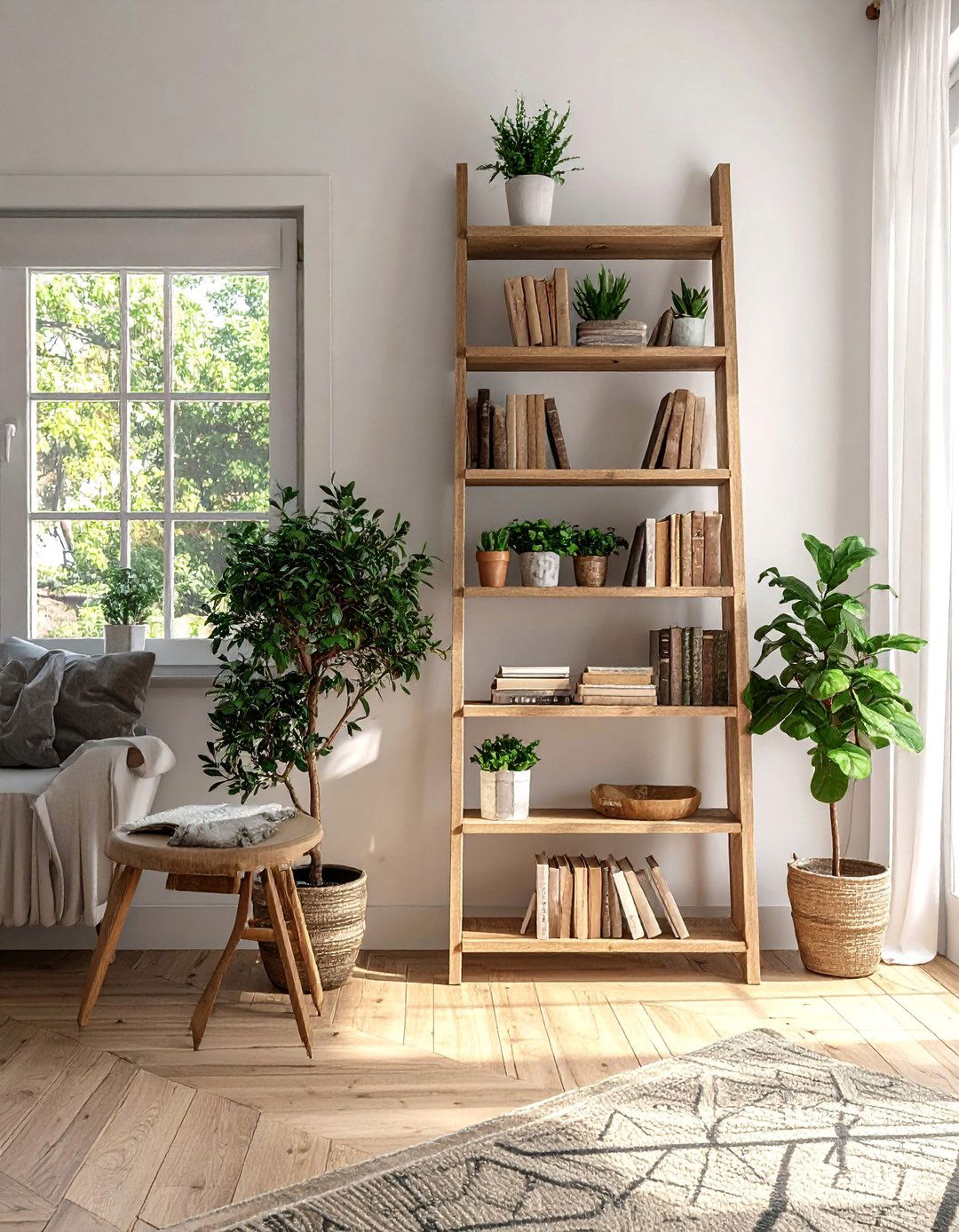

Leave a Reply